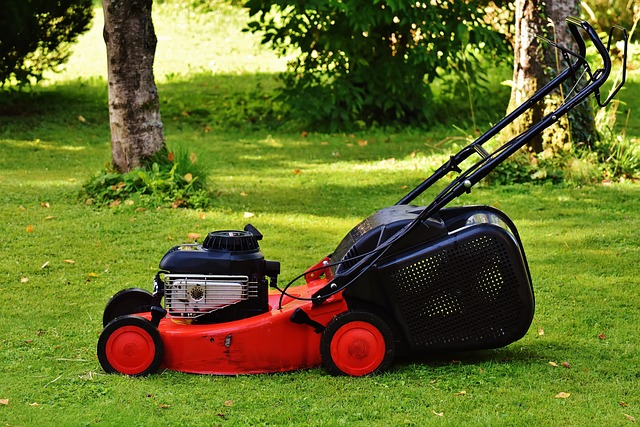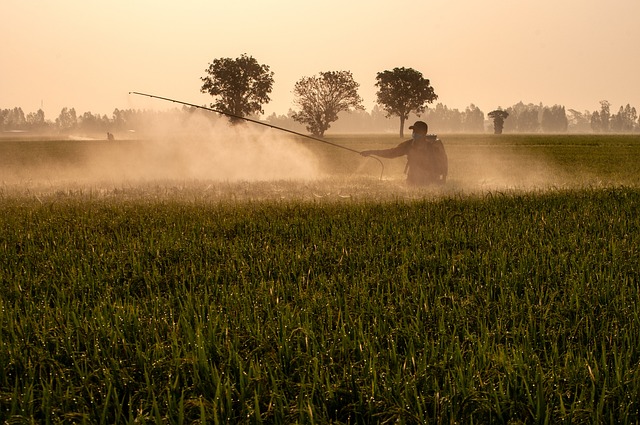Regular tree trimming and pruning are essential practices for maintaining healthy, attractive trees and a well-manicured yard as part of your lawn care and landscaping efforts. These tasks not only enhance the visual appeal but also protect trees from health issues, hazards like contact with structures or utility lines, and promote safety by ensuring clearances under the tree. Strategic removal of dead, diseased, or damaged limbs improves light and air circulation within the tree's canopy, which is vital for photosynthesis and overall tree vitality. Thinning the foliage can prevent windthrow by reducing wind resistance, and proper pruning can stimulate flower and fruit production while strengthening the tree's structure against storms. It's important to use appropriate tools and techniques, tailored to each species, and to prune at optimal times to minimize disease risks. Skilled arborists offer precision care that considers the unique needs of each tree species and can prevent pest infestations and disease infections. Properly maintained trees not only improve your property's curb appeal but may also increase its market value. Incorporating professional lawn care and landscaping services, including tree trimming and pruning, into your routine upkeep is key to a thriving outdoor environment. Always consult with certified arborists for personalized advice that aligns with your specific trees and local climate.
Tree trimming and pruning play pivotal roles in maintaining a healthy, aesthetically pleasing lawn. This article delves into the fundamental practices of tree care within landscaping, emphasizing the advantages of professional services for your yard’s vitality and visual appeal. We will guide you through effective pruning techniques that are integral to comprehensive lawn care routines. Join us as we explore how these practices contribute to a thriving landscape.
- Essential Practices in Tree Trimming and Pruning for Optimal Lawn Care and Landscaping
- Understanding the Benefits of Professional Tree Trimming and Pruning Services for Your Yard's Health and Aesthetics
- Step-by-Step Guide to Effective Tree Pruning Techniques as Part of Comprehensive Lawn Care and Landscaping Routines
Essential Practices in Tree Trimming and Pruning for Optimal Lawn Care and Landscaping

Engaging in regular tree trimming and pruning is a cornerstone of effective lawn care and landscaping, promoting the health and longevity of trees. These practices not only enhance the aesthetic appeal of a landscape but also ensure safety and prevent potential damage to structures or utility lines. By removing dead, diseased, or damaged branches, tree trimming allows light and air to penetrate the tree’s canopy, encouraging photosynthesis and overall tree health. This selective removal of growth, known as thinning, also reduces the risk of windthrow—a tree falling over due to strong winds—by lessening the tree’s wind resistance.
Pruning serves a dual purpose in lawn care and landscaping: it shapes trees to complement your yard’s design while maintaining a clearance for pedestrian and vehicular traffic below. Proper pruning techniques also stimulate flower and fruit production, as well as improve tree structure, which is crucial for withstanding storms and growing strong. It’s important to identify the right tools and methods for each tree species and to prune at the correct time of year to avoid harm. For instance, most deciduous trees should be pruned during dormancy to minimize the risk of disease transmission. By integrating these essential practices into your lawn care and landscaping routine, you can ensure that your trees remain healthy, beautiful, and an integral part of your outdoor space.
Understanding the Benefits of Professional Tree Trimming and Pruning Services for Your Yard's Health and Aesthetics

Regular lawn care and landscaping practices, including professional tree trimming and pruning services, are integral to maintaining a healthy and aesthetically pleasing yard. These services not only enhance the visual appeal of your outdoor space but also contribute significantly to the longevity and safety of your trees. Professional arborists understand the specific needs of different tree species, ensuring that each cut is precise and beneficial for the tree’s health. By carefully trimming branches, these experts remove any diseased, damaged, or dead wood, which can otherwise serve as entry points for pests and diseases, potentially threatening the entire tree’s well-being. This process also allows sunlight to penetate the canopy more effectively, promoting flowering and fruiting, and encouraging dense, strong branch growth. Moreover, strategically thinning the crown improves air circulation, which is crucial for disease prevention and can reduce wind resistance during storms, thereby safeguarding your trees against toppling. In addition to health benefits, well-maintained trees enhance the overall aesthetic of your property, increasing its curb appeal and potentially boosting property value. The skillful application of tree trimming and pruning services by professionals in lawn care and landscaping ensures that your trees are shaped to complement your yard’s design, creating a harmonious and tranquil outdoor environment.
Step-by-Step Guide to Effective Tree Pruning Techniques as Part of Comprehensive Lawn Care and Landscaping Routines

Effective tree pruning is a critical aspect of comprehensive lawn care and landscaping routines, enhancing both tree health and the overall aesthetic appeal of your landscape. To begin with, assess the condition of your trees in early spring or late winter when trees are dormant. This allows for clear visibility to identify dead, diseased, or damaged branches that need removal. Utilize sharp, clean pruning tools to make cuts at the node where a five-cents-sized leaf bud or an lateral branch connects to the main branch. Proper cutting ensures healing is quick and minimizes the risk of decay.
When pruning, start by removing any broken, diseased, or dead branches first, followed by crossing limbs, and then shape the tree as needed. Aim to maintain the tree’s structure and natural form, avoiding over-thinning which can weaken the tree. For young trees, remove only a small percentage of the foliage each year to allow for growth and development. Established trees can handle more substantial cuts, but always leave at least one-third of the live crown undisturbed to maintain energy reserves. Regularly scheduled pruning not only promotes tree health but also improves safety by reducing the potential for storm damage. Integrating these tree pruning techniques into your lawn care and landscaping routines contributes to a well-manicured yard that showcases healthy, vibrant trees. Always consult with certified arborists for specific recommendations tailored to your local climate and tree species, ensuring the longevity and beauty of your landscape.
Effective lawn care and landscaping hinge on maintaining the health and beauty of trees, a task expertly addressed by professional tree trimming and pruning services. This article has outlined essential practices for tree maintenance, elucidated the myriad benefits of these services for your yard’s vitality and curb appeal, and provided a detailed guide on how to prune trees skillfully. By integrating these practices into your lawn care regimen, you can ensure your landscape thrives and remains aesthetically pleasing throughout the seasons. Implementing these strategies will not only elevate your outdoor space but also foster a safer environment for you and your family to enjoy.
